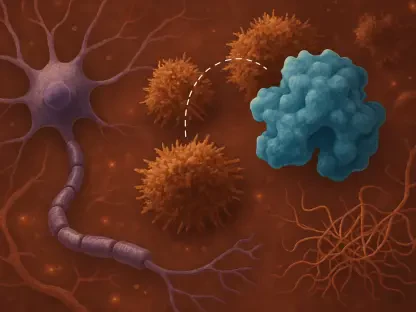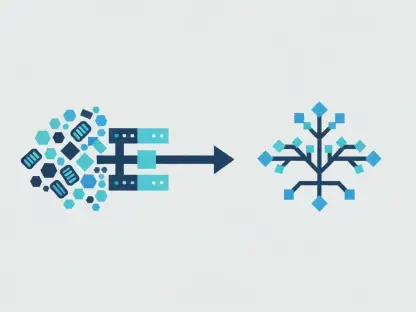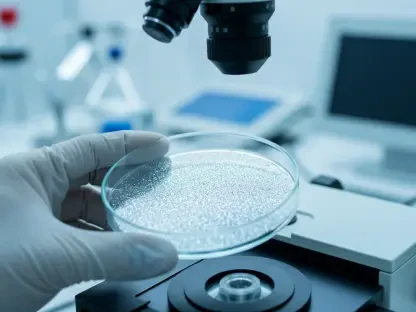The intricate dance between viruses and the host cells they infect has always been a subject of intense scientific inquiry. Recent research into SARS-CoV-2, the virus at the heart of the COVID-19 pandemic, has revealed a sophisticated mechanism through which this pathogen manipulates host cholesterol pathways. Through this strategic disruption, SARS-CoV-2 enhances its infectivity and survivability while deftly evading immune responses. By delving into how the virus orchestrates this manipulation via the viral protein ORF3a, scientists have uncovered potential therapeutic targets, offering hope for more effective treatments.
Cholesterol and Cellular Function
Importance of Cholesterol in Cells
Cholesterol is a cornerstone of cellular function, playing a pivotal role in maintaining cell membrane integrity and facilitating intracellular transport. This essential lipid is trafficked through lysosomes, where proteins such as Niemann-Pick C1 and C2 (NPC1 and NPC2) are crucial for its release and distribution. Any disruption in these pathways can lead to cholesterol accumulation within cells, subsequently impacting overall cellular health and functionality.
In the past, other pathogens like the Ebola virus have exploited similar pathways, leveraging the build-up of cholesterol to their advantage. This historical precedent forms the basis of recent studies indicating that SARS-CoV-2 might be employing a comparable strategy. By understanding these complex interactions, science can make strides in addressing the metabolic disruptions caused by such viral infections.
Viral Hijacking of Cholesterol Pathways
Viruses are known for their ability to hijack host cellular machinery, and SARS-CoV-2 has proven to be no exception. A groundbreaking study published on bioRxiv has provided compelling evidence of how SARS-CoV-2 infection significantly alters cholesterol metabolism by sequestering cholesterol within lysosomes. This process is primarily mediated by the viral protein ORF3a, which interacts intricately with cellular proteins to disrupt normal cholesterol trafficking.
The disruption caused by ORF3a in cholesterol pathways affects critical processes, such as protein trafficking and lipid metabolism, leading to severe cellular dysfunction. These alterations not only enhance viral survival and replication but also contribute to the overall pathogenicity of the infection. Understanding these mechanisms opens new avenues for therapeutic interventions aimed at restoring normal cellular functions and mitigating the virus’s impact.
SARS-CoV-2’s Hijacking Mechanism
Role of ORF3a in Cholesterol Sequestration
The viral protein ORF3a has emerged as a key player in sequestering cholesterol within lysosomes, facilitating significant disruptions in host cell metabolism. This sequestration impacts vital cellular processes including protein trafficking and lipid metabolism, which are essential for maintaining cellular homeostasis. Researchers explored these interactions by culturing various cell lines such as A549, HeLa, and Vero E6 and subsequently infecting them with SARS-CoV-2.
To further study these dynamics, researchers employed techniques such as immunofluorescence, filipin staining, and confocal microscopy to track cholesterol localization. High-content imaging and gas chromatography-mass spectrometry (GC-MS) were utilized to quantify cholesterol levels and analyze lipid species, providing a detailed understanding of the alterations induced by SARS-CoV-2 infection.
Experimental Techniques and Findings
Investigating the interactions between SARS-CoV-2 ORF3a and cellular proteins involved in lysosomal trafficking, particularly VPS39, yielded critical insights. VPS39 is a component of the HOPS complex, which plays a crucial role in lysosomal cholesterol egress. By using mutational analysis, researchers identified key residues within ORF3a that are responsible for these interactions, with mutations at residues W193 and Y184 shown to disrupt the normal functioning of this pathway.
Findings from these experiments revealed that SARS-CoV-2 infection leads to a dramatic increase in lysosomal cholesterol. Localization studies using ORF3a confirmed its presence in lysosomes, where it caused apparent swelling. Interestingly, this was not observed with the ORF3a protein of SARS-CoV, indicating a unique mechanism specific to SARS-CoV-2. The resultant disruption in cholesterol trafficking due to ORF3a’s interaction with VPS39 underscores its pivotal role in the virus’s pathogenicity.
Study Findings
Cholesterol Accumulation in Lysosomes
One of the study’s significant discoveries is that SARS-CoV-2 infection leads to a dramatic increase in cholesterol within lysosomes, a stark deviation from normal cellular function. ORF3a’s localization to lysosomes incites swelling, highlighting a distinct pathogenic mechanism unique to this virus. The interaction between ORF3a and VPS39 critically disrupts lysosomal cholesterol egress, causing it to accumulate.
This accumulation has far-reaching implications for cellular metabolism. The sequestration impairs essential cellular processes and promotes conditions conducive to viral survival and replication. Additionally, the findings emphasize how subtle variations in viral proteins, such as those between SARS-CoV and SARS-CoV-2, can lead to vastly different outcomes in terms of cellular impact and viral efficiency.
Impact of ORF3a Mutations
Mutational analysis sheds further light on the pathogenic process, particularly mutations at residues W193 and Y184 of ORF3a. These disruptions significantly alter the interaction between ORF3a and VPS39, reducing cholesterol accumulation and emphasizing the critical nature of these residues. Moreover, this sequestration is associated with decreased levels of bis(monoacylglycero)phosphate (BMP), a lipid instrumental in cholesterol transport and viral fusion with lysosomal membranes.
The reduction of BMP exacerbates lysosomal cholesterol buildup and creates an optimal environment for viral replication. Understanding these mutations and their effects paves the way for targeted therapeutic strategies that could interfere with these critical interactions, potentially mitigating the virus’s ability to hijack host cholesterol metabolism.
Strategic Cholesterol Management by SARS-CoV-2
Plasma Membrane Cholesterol Reduction
The study suggests an intriguing aspect of SARS-CoV-2’s strategy – its deliberate reduction of cholesterol at the plasma membrane. By strategically managing cholesterol levels, the virus limits secondary infections, preventing viral overload within a single cell. This ensures broader spread across the host, illustrating a sophisticated viral mechanism to balance infectivity and cell survival.
This selective manipulation highlights the intricate tactics employed by SARS-CoV-2 to optimize its replication process. It also underscores a potential area for therapeutic intervention, where disrupting this strategic cholesterol management could hinder the virus’s ability to maintain its infectivity and spread efficiently across host cells.
Broader Implications for Viral Pathogenesis
The elucidation of this novel mechanism offers significant implications for understanding viral pathogenesis. By targeting the ORF3a-VPS39 interaction or addressing the resultant disruptions in cholesterol trafficking, new therapeutic strategies could emerge. These interventions aim to alleviate metabolic complications associated with COVID-19, such as dyslipidemia and cardiovascular disease, by restoring normal lipid metabolism.
The potential for such therapeutic approaches to mitigate the immediate and long-term consequences of SARS-CoV-2 infection emphasizes the importance of continued research. As scientific understanding of these interactions deepens, the development of effective treatments targeting these mechanisms becomes increasingly feasible, providing hope for better management of the virus’s impact.
Therapeutic Potential
Targeting ORF3a-VPS39 Interaction
The discovery of SARS-CoV-2’s ability to disrupt cholesterol metabolism via the viral protein ORF3a marks a crucial advancement in understanding its pathogenicity. ORF3a’s role in sequestering cholesterol within lysosomes leads to significant cellular dysfunction and enhanced viral survival. The interaction between ORF3a and VPS39, essential for this sequestration, presents a promising therapeutic target.
Researchers are now focusing on developing interventions that can disrupt this interaction. By targeting ORF3a or directly interfering with its interaction with VPS39, it is possible to reduce cholesterol accumulation and restore normal cellular functions. This approach could play a vital role in mitigating the virus’s impact on host metabolism, thereby alleviating disease severity.
Restoring Lipid Metabolism
Restoring lipid metabolism is imperative for resolving the metabolic disturbances caused by SARS-CoV-2. The viral manipulation of cholesterol pathways underscores the necessity for innovative therapeutic strategies. Researchers are pursuing methods that could normalize cholesterol trafficking and address the lipid imbalances induced by SARS-CoV-2. Understanding the sophisticated viral strategy enhances our ability to develop treatments that manage the virus’s impact on global health. Researchers are optimistic that these findings will pave the way for innovative therapies and improved management of COVID-19, potentially reducing the virus’s impact on global health.









